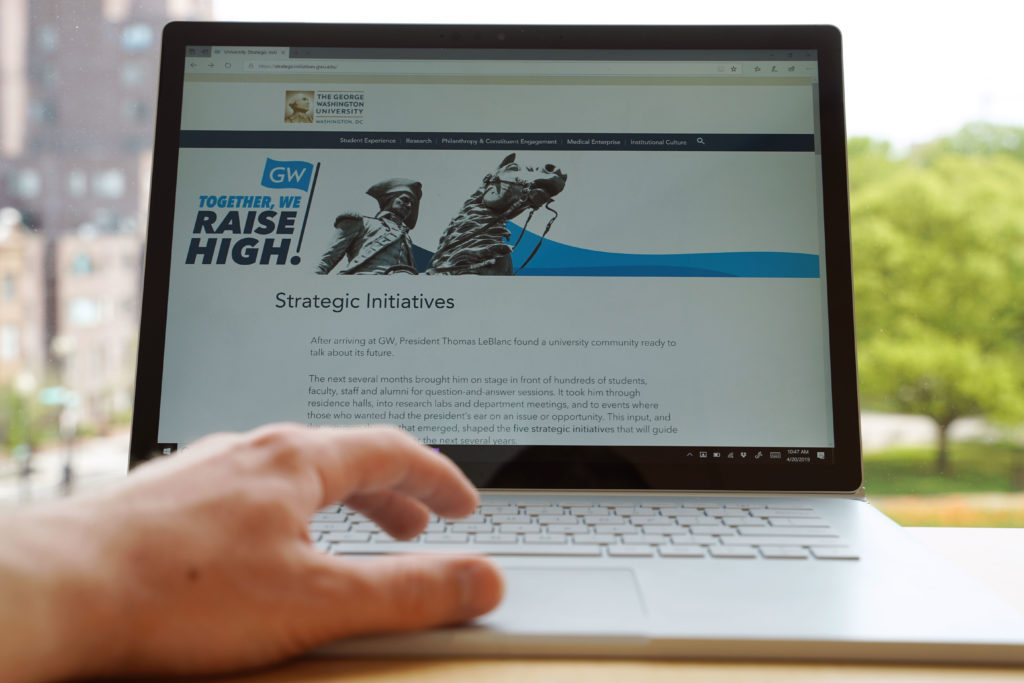Thousands of visitors have viewed the website that tracks University President Thomas LeBlanc’s progress on his top initiatives since the site launched last year, officials said.
Officials said the website, which debuted last April, provides students, faculty and staff with a centralized location to monitor improvements in LeBlanc’s five priorities, which include research, fundraising and alumni engagement, student experience and institutional culture. Higher education experts said officials can use feedback left by visitors to the website to guide their efforts in furthering the initiatives.
University spokeswoman Maralee Csellar said the top administrators who serve as “sponsors” of LeBlanc’s five strategic initiatives make updates to and post on the website “on a frequent basis.”
She added that officials post more frequently about “bigger” accomplishments, like the results of a faculty-led review of GW’s research ecosystem, she said. Csellar said the website includes an overview and goals for each initiative and shows the tangible changes administrators have made.
“The site is updated on a frequent basis so that our community members can check back whenever it is convenient for them to see the progress that we, as a community, are making together,” she said in an email.
Csellar said officials are collecting feedback on each initiative from faculty, students and staff through a form and participation in working groups. Each initiative’s page on the website includes a response form for visitors to provide feedback on the progress, and many of the initiatives include working groups that help sponsors conduct outreach.
She said officials plan to continue using the website in the “coming years,” but she declined to provide an exact timeframe.
Since the website’s launch, officials have added the names of faculty and staff working on each initiative and the University’s accomplishments furthering each of the five priorities. Officials have provided at least three updates on each initiative and more than 50 updates to the student experience initiative, like the introduction of a free 18th credit and the installation of a new crosswalk on H Street.
Higher education experts said officials can use the website to inform students, faculty and staff about their progress on the initiatives and gauge which issues they believe are the most important for administrators to address.
Rebekah Basinger, the principal consultant at the higher education advising company Basinger Consultants, said the ability for website viewers to provide feedback through response forms on the site will hold officials accountable.
She said officials should also include updates when they fail to address an initiative or encounter an obstacle in the process to remain transparent with the community. The community will not be able to progress if officials do not acknowledge which approaches have not worked, Basinger said.
“If there is real transparency, they will say if some of the things don’t work out as well, because that’s life,” she said.
Teboho Moja, a clinical professor of higher education at New York University, said the website will encourage members of the community to get involved by listing the officials that head each initiative and providing feedback forms, fostering an honest conversation.
But she said a website permitting feedback alone is not enough to deliver the institutional change administrators are aiming for. Officials should use the feedback they receive to determine which topics should be taken more seriously, she said.
“I see good intentions,” Moja said. “What needs to be seen is continuous communication and continuous engagement of the community.”
Charles Garris, the former chair of the Faculty Senate’s executive committee, said that at times, GW’s size has prevented community members from understanding administrators’ goals, and the website is a way to address the issue.
“One of the problems you have in big universities is things are going on, but people have no idea that these things are happening,” he said.
Garris added that the opportunity for students, faculty and staff to weigh in on initiatives will be a valuable tool for collecting feedback without having to wait for the results of a survey.
“You can’t fix things if you don’t know that they’re broken,” he said.





